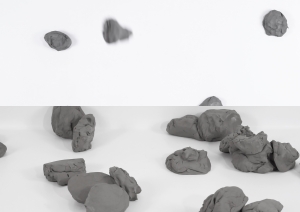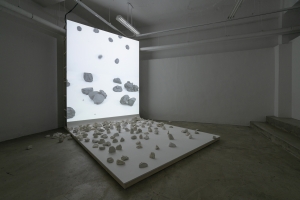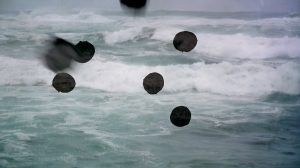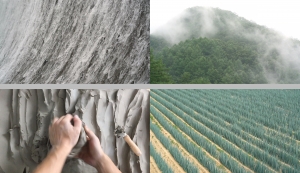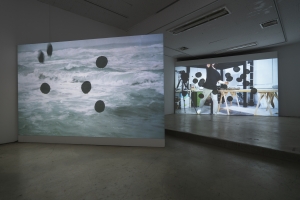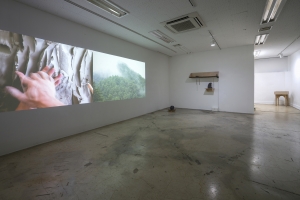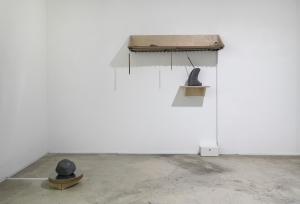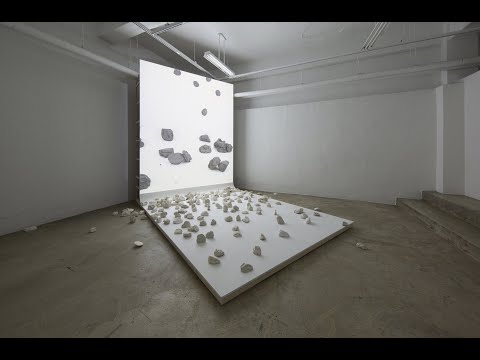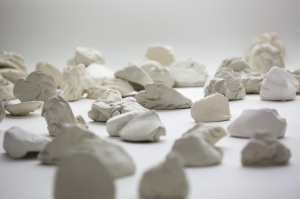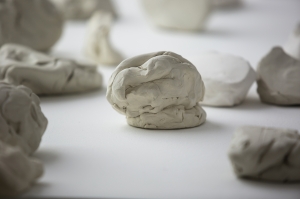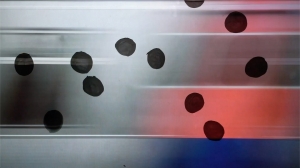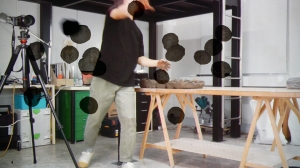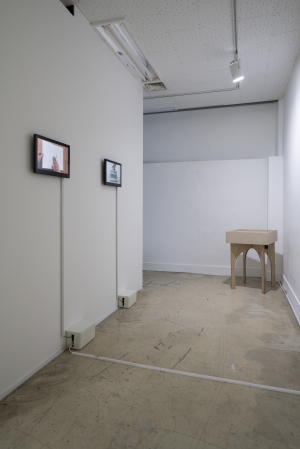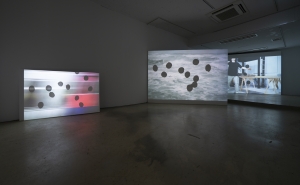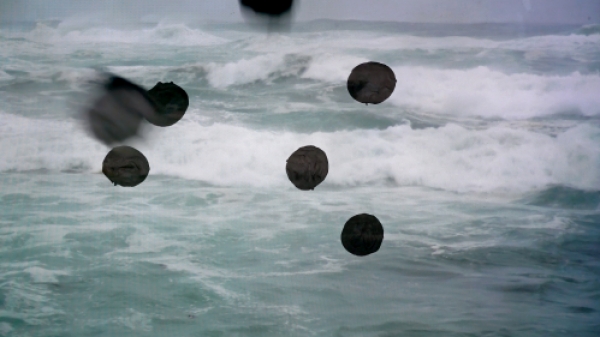전시 EXHIBITION
곡선의 용서
백승현의 <곡선의 용서>는 용서할 수 없는 완벽한 곡선을 그리기 위해 노력하는 가상의 한 개인의 모습을 통해, 완벽하다고 믿어온 사회의 규율이 사실은 개인을 좌절시키는 허상일 뿐이거나, 때로는 어처구니없는 모습을 하고 있다는 아이러니한 이야기를 큰 줄거리로 하고 있다. 작품에 빈번히 등장하는 반죽처럼 보이는 흙덩어리는 빵 공장에서 매일 똑같은 일을 했던 작가의 경험을 연상시키며, 노동하는 자아와 작가로서의 자아 사이에 존재하는 어긋나게 비슷한 괴리감을 상징한다. 개인과 사회의 관계, 개인으로 전해지는 사회의 실패에 대한 작가의 관심은 이번 전시에서 창작의 과정에 존재하는 실패에 대한 관심으로 이어진다.
-
실존적 되던지기 속에서 양안시의 개시
김남수 (안무비평)
부채감이란 것은 동양적 근대가 도제식 스승과 결별하면서도 전통 ? “근대 시기에 날조된 전통” ? 이라는 배를 타고 계속 갔더라면 하는, 실제로는 가지 않으면서도 ‘가지 않은 길’에 대한 상상적 선취가 먼저 작동하기 때문에 오는 미안함 같은 것이다. 주어진 관습과 궤도로부터 스승(들)이 여전히 도[道] ? 동양의 최고 진리를 몸으로 얻는다는 의미에서 “길”[way] ? 를 발견하고 있다고 하고, 교육 현장에서 엄숙주의적 연기를 하는 것에 수긍하지 못할 때조차 “그 깨달음을 이용해 보지도 못한 채 무한한 후회와 공포를 안고”(루쉰) ‘궤도파괴자’로서 외롭고 고독한 길을 나 홀로 가는 것은 아닌가 생각할 수 있다.
백승현 작가가 <곡선의 용서>이라는 제목을 선택하고 개인 전시를 진행했을 때, 우선 들어오는 큰 그림은 동양의 산수화 전통처럼 힘이 센 사회적 대타자로서의 언어를 거부하고 그 펀더멘탈을 갈아엎는 작업이었다. 동양의 산수화 전통처럼 송대 이후 천년 가까운 세월 동안 억압적인 규제이념으로 작용해온 심미적 법칙들을 체득하는 것은 오로지 구전심수[口傳心授, 입으로 전하지만 마음으로 받는다]라는 도제식 교육 시스템에서 가능하다는 관습은 산수화가 갖는 자연과 인간 사이의 상관적 사유를 박제화한 것이고, 이미 생기를 잃어버린 조화[造花] 비슷한 것에 지나지 않는다는 것이다.
작가는 이번 전시에서 이 거대한 관습적 교육의 유산이 사회적으로 엄존해 있는 것이 문제가 아니라 자신의 실존 ? “눈 앞에 여전히 있음”이란 사르트르적 의미에서 ‘실존’ ? 에 여전히 장기지속하는 유령처럼 달라붙어 있는 내면풍경을 해체하고자 시도한 것으로
보인다. 이 해체에는 앞서 말한 부채감이 뒤따라오는데, 이 부채감은 양가적인 것이어서 해체가 물리적인 파괴가 아니라 내재적인 재음미, 나아가 근본적인 재성찰에 가까운 형국이 되도록 촉발한다. 즉 작가가 대학시절 강의에서 던져졌던 스승의 한 마디를 잘못 알아듣고, 그로부터 심오하고 형이상학적인 ‘궤도이탈’의 화두[話頭]로 삼게 되었지만, 나중에 스승의 그 관습의 빈곤, 철학의 빈곤을 깨달으면서도 자신이 꾸려간 화두의 살림살이를 그대로 살려나가게 되었다는 것이다.
그래서 백승현 작가는 이 내친 걸음의 ‘궤도이탈’의 화두가 철회되는 것이 아니라 자신에게 실존적으로 작용하여 저 벽의 평면공간에 흙으로 이겨진 반죽 한 덩이가 던져졌을 때 그 벽에 달라붙는가 아닌가 하는 ‘치명적 도약’(마르크스)의 분수령을 자신의 전시 한가운데에 설치하고자 했다. 동양적 전근대로부터 끄달려온 수많은 유령적인 것(들)과 결별한다는 것은 마음의 인지주의적 작동이 그렇게 쉽게 응해주지 않는다. 그래서 작가는 흙 한 덩이가 자신에 의해 벽에 던져져서 벽에 붙는 것과 툭하고 떨어지는 것, 이 물질론적인 투사가 있는 퍼포머티브한 영상으로 양안[兩岸, ‘차안’과 ‘피안’이라는 두 개의 언덕]을 만들어낸다. 이 양안의 갈림길, 이것은 “존재하느냐 존재하지 않느냐, 이것이 문제로다”라는 햄릿적 수행성이 깃든 영역이다. 이는 마음을 대상화하지 않으면, 마음을 알 길이 없지만, 그렇게 대상화하는 순간 마음의 인지는 그 폭과 깊이가 본래의 마음보다 훨씬 더 제한적이 된다는 딜레마를 안고서 스스로를 본래 자신이 거처하고 있는 동양적 공간 속으로 되던지는 작업이다. 존재하기 위하여.
양안시[兩岸視, 두 개의 언덕 ‘차안’과 ‘피안’을 동시에 보기]의 영역에서 <곡선의 용서>은 작동하고 있으며, 포물선을 그리며 날아가는 흙덩이는 그 운동의 서슬에 의해 마치 ‘살아있다’라고 느끼는 하나의 존재처럼 육박해온다. 왜냐하면 ‘차안’, 즉 흙덩이가 달라붙은 벽면과 ‘피안’, 즉 흙덩이가 달라붙지 못하고 툭 떨어진 바닥 사이의 날카로운 분할은 그 달라붙음의 ‘치명적 도약’이 실패한 자의 운명처럼 죽음충동이 나타나고 있기에 역설적으로 ‘살아있다’는 자의식이 도드라진다. 오브제에 의탁하는 순간, 물활론적인 열림이 이 퍼포머티브한 영상에 결단적으로 개입하고, 작가의 의도를 따라 관람자는 ‘차안’과 ‘피안’을 동시에 보는 시각에 서서히 눈떠간다. 이는 영상 속의 바닥에 있는 흙덩이와 실제 전시장 바닥에 초벌로 구워낸 흙덩이, 영상 이미지와 오브제라는 대조에 의해 강화된다.
“모든 것이 나뉘지만,
다만 자신 안에서 나뉜다.”(베케트)
양안은 작가의 내면적 공간이며, 그 내면의 외화로서 설치된 영상은 결단주의적 법(칼 슈미트)을 정초하듯 스스로를 위한 입법[立法, 법을 세우기]으로서 동양의 산수화를 해체한다. 알레고리적인 퍼포먼스로서 삶과 죽음이 포물선을 그리면서 날아가는 흙덩이에 매개되듯 이 입법 활동은 작가가 수백년 동안 내려온 동양의 산수화 전통에 실존적으로 저항하는 것이 아니라 대체하고 심지어 폐기할 수 있다는 가능성을 열어둔다. 여기에는 산수화를 연상할 수 있는 그 무엇도 쉽게 코드화되어 있지 않다. 단지 보이지 않지만 느껴지는 가상의 포물선, 스크린의 얼룩처럼 암흑점, 작가 자신이 흙덩이를 만드는 과정에서 나타나는 원초적인 노동의 흔적과 근육, 산[山]과 물[水]로 파구[破構, 산수[山水]로 구성된 것을 내파시킴]한 각각의 시원적 영상 등등이 전시 작품들로 보완하며 제 스스로의 목소리를 내며 설치되어 있다. 이것은 재코드화[recoding, 다시 코드를 만드는 작업]를 의도하지 않은 채, 대체되고 폐기된 전통의 잔존하는 것들을 걷어내면서 다시 전유한다고 할까.
작가는 ‘자신 안에서’ 그 걷어내기와 전유를 질문하고, 또한 스스로의 삶 속에서 행해온 노동 ? 빵반죽하고 빵 만드는 베이커리 노동 ? 의 리얼리티를 그 산수화의 해체주의적 작동에 대해 질문한다. 빵반죽하던 노동에 의해 다져진 근육의 사유로써 산수화의 심미주의적 곡선이 화선지에 뿌려지는 귀족적 활동을 대체하면서 ‘차안’과 ‘피안’ 사이의 양안시를 열어간다. 즉 이 메타적이며 내재적인 방식으로 탈중심화된 산수화 전통을 흙덩이가 날아가 죽고 살고 하는 평면 ? 마치 알레고리적으로 생활세계인 것처럼 ? 의 현실에 맞닥뜨리게 한다. (육체적) 노동자로서의 아이덴티티와 (정신적) 귀족으로서의 아이덴티티의 교차가 갈등적인 양상으로 나타나 이미 평면 위에서 비정형의 논쟁을 하고 있는 형국이다. 거기에 “일반노동과 예술노동 사이의 차이는 무엇인가” 같은 묵직하면서도 원초적인 아젠다가 함께 동행한다.
“실존은 항상 개인적이기 마련이라 당연히 보통사람들의 틀에는 꼭 들어맞을 수는 없으며 거기에서 삐져나온 것들이 결과적으로는 새로움으로 등장하게 되는 것이다. 그리고 실존은 반드시 어떤 상황에서만 가능하다. 따라서 그 다음에도 어떤 공통적인 흔적을 갖게 되는데 그게 시대양식이 되어 나타나는 것이다."(백남준, 1959)
‘날조된 전통’으로서 동양적 근대로 코드화된 산수화 역시 어느 개인의 창안(들)에 의해 이루어진 작업이라는 과거가 지식의 고고학에 의해 밝혀지지만, 그럼에도 불구하고 용서할 수 없는 억압과 지배의 곡선을 포함하고 있다. 실존이란 다시 말하지만, 자신이 있는 곳에 자기자신을 되던지는 작업으로서 그 되던지는 과정에 ‘삐져나온 것들’이 결과적으로 새로움을 적층시켜온 것이다. 그리고 하나의 시대양식으로서 ‘날조된 전통’이 있는 셈이고, “역사는 아무리 더러운 역사라도 좋다”(김수영, 시 ‘거대한 뿌리’ 중에서)라는 식의 허무주의적 태도가 추인해왔다. 백승현 작가는 이러한 방식의 제3세계적 작동, 세대간의 교량을 건널 때 “심장을 멈추는 연습”을 해온 방식의 후진국적 작동을 폐기한다. 그는 그냥 자신을 던지듯 흙덩이를 던지면서 묻는다. 저기 해방된 곡선이 있지 않느냐. 저기 ‘차안’과 ‘피안’ 사이를 나는 존재가 보이지 않느냐.
이 퍼포머티브한 언행 행위, 그 행위의 장치로서 ‘양안시’의 가동이 얼마만큼 동양적 근대 속에 수습되어 있는 ‘날조된 전통’을 흔들 수 있는지는 모르지만, 백승현 작가가 개인으로서 작업 너머의 삶, 지난한 삶으로부터 받은 체험의 결, 고뇌의 결, 방황의 결(들)이 이러한 작업 속에 고스란히 녹아들어서 마치 루쉰처럼 혹은 소세키처럼 근본적인 질문을 던지면서 벽에 암흑지대를 남기는 것이 매우 의미심장하게 다가온다. 좋은 산수화라든가 새로운 산수화가 아니라 산수화 아님의 상태에 놓여져서 곡선으로 풀어헤쳐진 어떤 변성[變性] 상태에 있다는 것, 그로부터 모든 방황을 끝내고 수미산처럼 우뚝 서겠다는 것은 이 결단주의적 퍼포머티브의 범주에 진하게 나타나고 있기 때문이다. 이것이 백승현 작가가 다시 작업을 열심히 하겠다는 스스로의 각성 상태가 포지티브 피드백으로 담겨있는 것이기도 하고, 그런 실존적 열림이 작가 자신을 하나의 영상 속에 담아낸 것이기도 하다고 보여진다.
양안시[兩岸視]는 또한 서구와 동양 사이라는 또다른 ‘차안’과 ‘피안’을 보게 되고, 백승현 작가에게 이러한 두 개의 언덕은 역시 이번 전시의 맥락과 차원 안에 갈무리되어 있다. “선혈이 뚝뚝 듣는 양고기와 향기로운 포도주 그리고 헌걸찬 여성을 그린 회화”를 낳은 서구와 달리, “우리들은 ‘태어나면서부터 이들과는 운명과 경우가 판이한 동양인’이고, 지극히 순수한 욕망마저 때로는 사회적 단죄를 받게 되는 관습과 법제[法制]를 짊어진, 곧 ‘말을 하면 입술이 시린’ ? 발언하면 후폭풍이 밀려온다는 ? 국민이라는(나가이 가후) 잠재의식이 여전하다. 그런데 백승현 작가는 이러한 기울어진 동서의 시소 사이에서 방황하는 것이 아니라 정직하게 양안 사이의 문화적 갈등 속에서 서구로부터 받은 이성적 거울효과와 함께 동양의 내재적 성찰을 진행해온 결과, 이처럼 새로운 평면, 실존적 되던짐이 있는 평면이라는 자신만의 다층적, 결단주의적 근대를 창출했다고 할까.
여기에는 허술하고 온정주의적인 용서가 없다.
단지 작가의 온전한 곡선이 나타난다. 곡선을 타고 가는 새판이 있다.
Opening of binocular vision in existential throwing-back
Kim NamSoo (Choreography critic)
A sense of indebtedness is a kind of regret derived from the initial activation of imaginative preoccupation over ‘the road not taken,’ which would mean that Asian modernity might have kept on sailing on the ship of tradition ? the tradition fabricated in the modern period ? although it actually got separated from the apprenticeship-style teacher. One may wonder if he or she is going alone on a lonely road as an ‘orbit breaker’ “unable to take advantage of the realization, with infinite regret and fear (Lu Xun),” even when he/she can’t agree to the words of the teacher(s) that they are finding Tao (道) ? the ‘way’ in the meaning that they obtain the highest truth through their bodies ? from conventions and orbits bestowed on them or approve the way they act out rigorism in the fields of education.
When Baek, SeungHyun held a solo exhibition under the title “Forgiving Curves” that he himself chose, the first big painting that caught attention was the one that denied language as a social ‘big other’ as powerful as the Asian landscape painting tradition and overturned its fundamentals. He suggests that the convention that acquiring aesthetic principles ? which have ruled as oppressive regulatory ideas for almost a thousand years since the Song Dynasty ? is only possible under the apprentice-style education system, represented by the idiom “oral teaching inspires true understanding (口傳心授),” such as the Asian landscape painting tradition, is none other than taxidermy of the relational reasoning between nature and human or something similar to lifeless artificial flowers.
In the exhibition, the artist seems to have attempted deconstructing the inner landscape stuck like a persistent ghost to his own existence ? ‘existence’ as in Sartre’s ‘existence’ that
means “still being in front of the eyes” ? rather than the problem of the social influence of the gigantic legacy of this conventional education. This deconstruction is followed by the sense of indebtedness mentioned earlier, which is ambivalent and leads the deconstruction not to physical destruction but closer to the internal reappreciation, or even fundamental reconsideration. It is related to the artist’s experience from a lecture he took while he was in college, when he misunderstood the professor’s remark and took up a profound and metaphysical topic of ‘orbit deviation.’ Later, even after he realized the professor’s poverty of the convention, or the poverty of philosophy, he continued to work on the topic as his own.
Baek tried to install the watershed of the ‘fatal leap (Marx)’ of the topic of ‘orbit deviation’ ? which he suspected would act existentially on him and make a lump of clay thrown on the plane space of the wall stuck there ? at the center of his exhibits. The cognitive working of the mind does not easily approve the breakup with countless ghosts dragged on from the premodern Asia. Thus, the artist created two shores (two shores of ‘this world’ and ‘nirvana’) with a performative video that gives materialistic projection of some lumps of clay thrown by him stuck on the wall and others bouncing off the wall and falling on the floor. The turnoff to the two worlds is the realm of performativity similar to Hamlet’s as expressed by his words “To be or not to be, this is the question.” If the mind is not objectified, you cannot understand it. However, the moment it is objectified, the cognition of the mind becomes much more limited than the original mind in both the depth and width. His work is to throw back himself to the Asiatic space where he has been residing, bearing the dilemma, in an attempt to exist.
“Forgiving Curves” works in the realm of binocular vision (simultaneous viewing of the two shores of ‘this world’ and ‘nirvana’) and the lump of clay flying in an arc approaches us like a live being due to its movement. As the sharp division between ‘this world,’ or the wall where
58 59
the lump is stuck and ‘nirvana,’ from which the lump has fallen, represents the death drive of someone whose ‘fatal leap’ has failed like in the fate, the self-consciousness of ‘being alive’ is, paradoxically, even more striking. The moment they entrust themselves to the objects, hylozoistic opening intervenes resolutely in the performative video; and viewers gradually open their eyes to the simultaneous binocular vision of ‘this world’ and ‘nirvana’ according to the artist’s intention. This is reinforced by the contrast between the lumps of clay on the floor in the video and the actual lumps of clay, made by biscuit firing, on the floor in the exhibition hall, or that between video images and objects.
“Everything divides, but into itself.” (Samuel Beckett)
The two shores represent the artist’s internal space, and the video installed by externalizing the space deconstructs Asian landscape painting as the legislation for itself, as if to lay the cornerstone for decisionist law (Carl Schmitt). Just as life and death are mediated by the lump of clay flying in an arc in an allegorical performance, this legislative action does not existentially resist the age-old Asian tradition of landscape painting but opens the possibility of replacing or even disposing it. Here, nothing that may be associated with landscape painting has been coded easily. There are just an imaginary arc, palpable although invisible, dark blots that look like stains on the screen, traces of basic labor and muscles of the artist resulting from the process of producing lumps of clay, primitive videos on the implosion with mountains and water, etc. installed making their own voices while complementing the exhibits. This seems to be removing the remnants of replaced and discarded tradition and taking them back, without any intention of recoding.
The artist questions the removal and taking-back ‘within himself’ as well as the reality of labor that he has maintained in his life ? kneading doughs and baking ? in relation to the deconstructive workings of the landscape painting. The contemplation on the muscles built by the labor of dough kneading replaces the aristocratic actions of the aesthetic curves being scattered on the paper in landscape painting, opening up the binocular vision between ‘this world’ and ‘nirvana.’ Through this inherent meta-method, the decentralized landscape painting tradition is faced with the reality of the plane where lumps of clay are thrown and die or survive, as if in an allegorical life-world. The intersection of the identity as a (physical) worker and that as a (mental) aristocrat appears as a conflicting situation of atypical arguments on the plane. The scene is also accompanied by a heavy yet basic agenda of “what is the difference between ordinary labor and artistic labor?”
“Existence is always individual; so naturally, it cannot fit the framework of ordinary people, and things that stick out of that emerge as new things in the end. Also, existence is only possible in certain circumstances. Therefore, it shows a common trace with the past existence, and this appears as the style of the age.” (Nam June Paik, 1959)
Although the landscape painting coded as ‘fabricated tradition’ of Asian modernity is revealed to be the outcome of the idea(s) of a certain individual through the paleontology of knowledge, it contains the curves of unforgivable suppression and occupation. I would like to reiterate that existence is the work of throwing oneself back, with the things that stick out in the process laminating novelty in the end. There is ‘fabricated tradition’ as a style of the age, and the nihilistic attitude represented by the passage “history is good even if it is a dirty history” (Kim Su-yeong, “The Great Root”) has ratified it. Paek abolishes this third-world-style, or underdeveloped-style working of ‘practicing holding one’s heartbeat’ when crossing the intergenerational bridge. He asks while throwing a lump of clay as if to throw himself. Don’t you see the liberated curves there? Don’t you see the being that flies between ‘this world’ and ‘nirvana’?
It is uncertain how much this performative behavior, and the workings of ‘binocular vision’ as the tool for the behavior, can shake up the ‘fabricated tradition’ contained in Asian modernity. However, it feels deeply significant that Baek has completely melted his life as an individual beyond his works, the texture of his experience from a hard life, the texture of his agonies, and the texture of wandering all in his works, posing fundamental questions like Lu Xun or Natsume Soseki and leaving dark blots on the wall. It is because his will to be in a certain state of degeneration unraveled to form curves as non-landscape painting rather than a good or new landscape painting, and to finish his wandering for good and stand on his own like Sumeru, is clearly demonstrated in this decisionist performative category. It is seen to represent the artist’s state of awakening and determination to concentrate on his work again in a positive feedback, as well as such an existential opening carrying the artist in the video.
Binocular vision leads to the observation of another ‘this world’ and ‘nirvana’ in the West and the East, and Baek has arranged these two shores in order within the context and dimension of the exhibition. Unlike the West that gave birth to “paintings of bloody lamb meat, fragrant wine and elated women,” we are “Asians who were born with completely different fates and cases from them” with unchanging subconscious of being the people burdened with conventions and legislative system, whose innocent desire is subject to social punishment at times, and whose “lips get cold after saying something” ? meaning aftereffect of a remark (Nagai Kafu). Meanwhile, Baek does not wander between the uneven see-saw of the East and the West but has honestly maintained introspection on the East within the cultural struggle between the two shores, with the rational mirror effect received from the West, thereby creating his own unique multi-layered decisionist modernity in the form of a new plane with existential throwing-back.
There’s no careless or paternalistic forgiveness here. Only the artist’s curves appear intact. Here is a new start riding on the curves.
- 기간
- 2020-11-17 ~ 2020-11-29
- 관련행사






